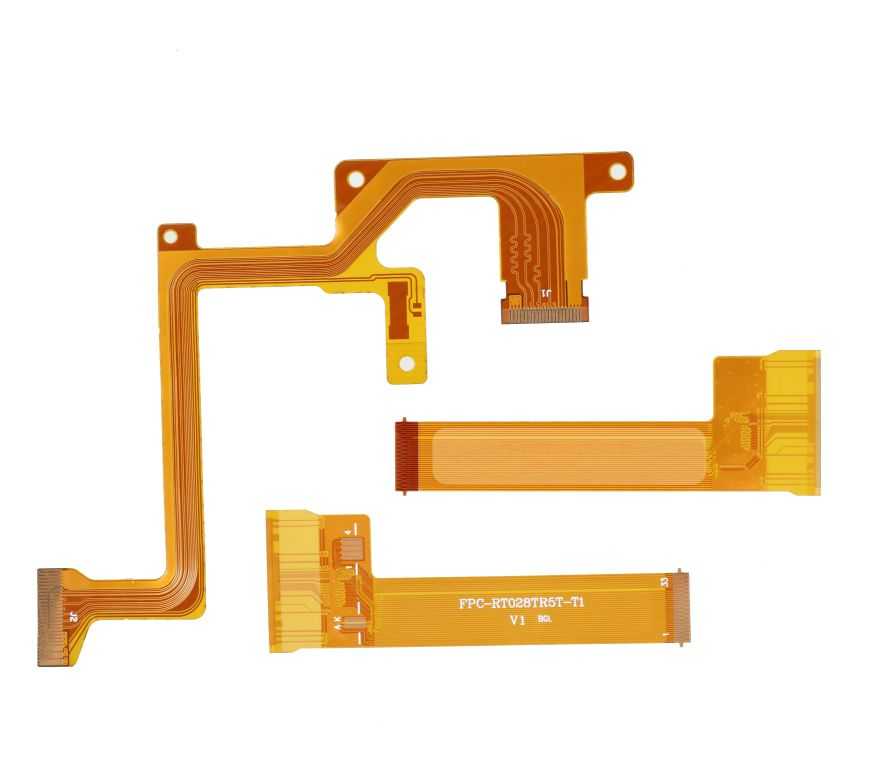The flexible circuit board can be freely bent, wound, and folded. The flexible circuit board is built with polyimide film base material. The flexible circuit board has different processes according to the number of layers. The process is divided into double-sided flexible circuit board and multilayer flexible circuit board. The FPC can withstand millions of dynamic bending without damaging the wires. It can be arranged arbitrarily according to the space layout requirements, and can move and expand in three-dimensional space, so as to achieve the integration of component assembly and wire connection; Flexible circuit boards can greatly reduced the volume and weight of electronic products , which meets the modern electronics products trend toward high density, miniaturization and high reliability.
The structure of the flexible circuit board is decided by the number of layers of conductive copper foil, it is divided into single-layer flex PCB, double-layer flex PCB, multilayer flex PCBs.

(1) Substrate: The material is polyimide (POLYMIDE), which is a high-temperature resistant, high-strength polymer material. It can withstand a temperature of 400 degrees Celsius for 10 seconds, and its tensile strength is 15,000-30,000 PSI. The 25μm thick substrate is the cheapest and the most common application. If the circuit board needs to be harder, a 50μm substrate should be used. Conversely, if the circuit board needs to be softer, a 13μm substrate is used.
(2) scotch tape: It is divided into epoxy resin and polyethylene, both of which are thermosetting glue. The strength of polyethylene is relatively low. If you want the circuit board to be softer, choose polyethylene. The thicker the substrate and the transparent glue on it, the harder the circuit board. If the circuit board has a relatively large bending area, you should try to choose a thinner substrate and transparent glue to reduce the stress on the surface of the copper foil, so that the chance of microcracks in the copper foil is relatively small. Of course, for such areas, single-layer boards should be used as much as possible.
(3) Copper foil: divided into two types: rolled copper and electrolytic copper. Rolled copper has high strength and bending resistance, but it is more expensive. The price of electrolytic copper is much cheaper, but its strength is poor and it is easy to break. It is generally used in occasions where it is rarely bent. The choice of copper foil thickness depends on the minimum lead width and minimum spacing. The thinner the copper foil, the smaller the minimum achievable width and spacing. When choosing rolled copper, pay attention to the rolling direction of the copper foil. The rolling direction of the copper foil should be consistent with the main bending direction of the circuit board.
(4) Protective film and its scotch tape: 25μm protective film will make the circuit board harder, but the price is cheaper. For circuit boards with relatively large bends, a 13μm protective film is best. Transparent glue is also divided into epoxy resin and polyethylene, and the circuit board using epoxy resin is relatively hard. After the hot pressing is completed, some transparent glue will be extruded from the edge of the protective film. If the size of the pad is larger than the opening size of the protective film, the extruded glue will reduce the size of the pad and cause its edges to be irregular. At this time, transparent glue with a thickness of 13μm should be used as much as possible.
(5) Pad plating: For circuit boards with large bending and exposed pads, electroplated nickel + electroless gold layer should be used. The nickel layer should be as thin as possible: 0.5-2μm, chemical gold layer 0.05-0.1 μm.














XPCB Limited is a premium PCB & PCBA manufacturer based in China.
We specialize in multilayer flexible circuits, rigid-flex PCB, HDI PCB, and Rogers PCB.
Quick-turn PCB prototyping is our specialty. Demanding project is our advantage.
Tel : +86-136-3163-3671
Fax : +86-755-2301 2705
Email : info@x-pcb.com
© 2024 - XPCB Limited All Right Reserve